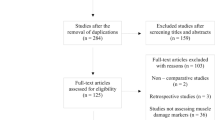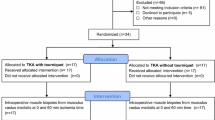Abstract
Introduction
In Europe the minimized transgluteal (TG) and anterolateral (AL) approaches are increasingly preferred in hip arthroplasty (THA).
Method
The present investigation determined which of these approaches causes the least muscle trauma. Forty patients who received a THA were enrolled in this prospective randomized study. Muscle trauma was quantified by perioperatively measuring the serum concentration of skeletal troponin I (sTnI). The Harris hip score (HHS) was determined before and 12 months after surgery.
Results
It increased significantly in all patients without being different between the groups (AL, 48.2→83.6; TG, 50.8→85.9). Patients in the TG group had a higher sTnI than those in the AL group 24 h postoperatively (21.6 vs. 10.9 nmol/ml, p = 0.022). The AL approach results in a reduced muscle traumatization compared with the TG approach, without this being revealed by the HHS.


Similar content being viewed by others
References
Laffosse JM, Chiron P, Tricoire JL, Giordano G, Molinier F, Puget J (2007) Prospective and comparative study of minimally invasive posterior approach versus standard posterior approach in total hip replacement. Rev Chir Orthop Reparatrice Appar Mot 93:228–237
Jerosch J, Theising C, Fadel ME (2006) Antero-lateral minimal invasive (ALMI) approach for total hip arthroplasty technique and early results. Arch Orthop Trauma Surg 126:164–173
Lawlor M, Humphreys P, Morrow E, Ogonda L, Bennett D, Elliott D, Beverland D (2005) Comparison of early postoperative functional levels following total hip replacement using minimally invasive versus standard incisions. A prospective randomized blinded trial. Clin Rehabil 19:465–474
McMinn DJ, Daniel J, Pynsent PB, Pradhan C (2005) Mini-incision resurfacing arthroplasty of hip through the posterior approach. Clin Orthop Relat Res 441:91–98
Ogonda L, Wilson R, Archbold P, Lawlor M, Humphreys P, O’Brien S, Beverland D (2005) A minimal-incision technique in total hip arthroplasty does not improve early postoperative outcomes. A prospective, randomized, controlled trial. J Bone Jt Surg Am 87:701–710
Bennett D, Ogonda L, Elliott D, Humphreys L, Lawlor M, Beverland D (2007) Comparison of immediate postoperative walking ability in patients receiving minimally invasive and standard-incision hip arthroplasty: a prospective blinded study. J Arthroplast 22:490–495
Howell JR, Masri BA, Duncan CP (2004) Minimally invasive versus standard incision anterolateral hip replacement: a comparative study. Orthop Clin North Am 35:153–162
Nakata K, Nishikawa M, Yamamoto K, Hirota S, Yoshikawa H (2009) A clinical comparative study of the direct anterior with mini-posterior approach two consecutive series. J Arthroplast 24:698–704
Lin DH, Jan MH, Liu TK, Lin YF, Hou SM (2007) Effects of anterolateral minimally invasive surgery in total hip arthroplasty on hip muscle strength, walking speed, and functional score. J Arthroplast 22:1187–1192
Roth A, Venbrocks RA (2007) Total hip replacement through a minimally invasive, anterolateral approach with the patient supine. Oper Orthop Traumatol 19:442–457
Wohlrab D, Hagel A, Hein W (2004) Advantages of minimal invasive total hip replacement in the early phase of rehabilitation. Z Orthop Ihre Grenzgeb 142:685–690
Pagnano MW, Leone J, Lewallen DG, Hanssen AD (2005) Two-incision THA had modest outcomes and some substantial complications. Clin Orthop Relat Res 441:86–90
Mardones R, Pagnano MW, Nemanich JP, Trousdale RT (2005) The Frank Stinchfield Award: muscle damage after total hip arthroplasty done with the two-incision and mini-posterior techniques. Clin Orthop Relat Res 441:63–67
Harris WH (1969) Traumatic arthritis of the hip after dislocation and acetabular fractures: treatment by mold arthroplasty. An end-result study using a new method of result evaluation. J Bone Jt Surg Am 51:737–755
Simpson JA, Labugger R, Collier C, Brison RJ, Iscoe S, Van Eyk JE (2005) Fast and slow skeletal troponin I in serum from patients with various skeletal muscle disorders: a pilot study. Clin Chem 51:966–972
Schaser KD, Bail HJ, Schewior L, Stover JF, Melcher I, Haas NP, Mittlmeier T (2005) Acute effects of N-acetylcysteine on skeletal muscle microcirculation following closed soft tissue trauma in rats. J Orthop Res 23:231–241
Roy BR, Binns MS, Horsfall H (2001) Radiological diagnosis of abductor denervation after hip surgery. Skeletal Radiol 30:117–118
Siebenrock KA, Rosler KM, Gonzalez E, Ganz R (2000) Intraoperative electromyography of the superior gluteal nerve during lateral approach to the hip for arthroplasty: a prospective study of 12 patients. J Arthroplast 15:867–870
Ince A, Kemper M, Waschke J, Hendrich C (2007) Minimally invasive anterolateral approach to the hip: risk to the superior gluteal nerve. Acta Orthop 78:86–89
Conflict of interest
The authors declare that they have no conflict of interest.
Author information
Authors and Affiliations
Corresponding author
Rights and permissions
About this article
Cite this article
Matziolis, D., Wassilew, G., Strube, P. et al. Differences in muscle trauma quantifiable in the laboratory between the minimally invasive anterolateral and transgluteal approach. Arch Orthop Trauma Surg 131, 651–655 (2011). https://doi.org/10.1007/s00402-010-1190-4
Received:
Published:
Issue Date:
DOI: https://doi.org/10.1007/s00402-010-1190-4




